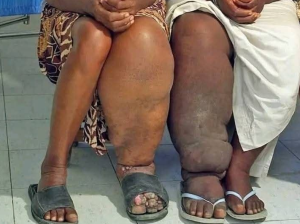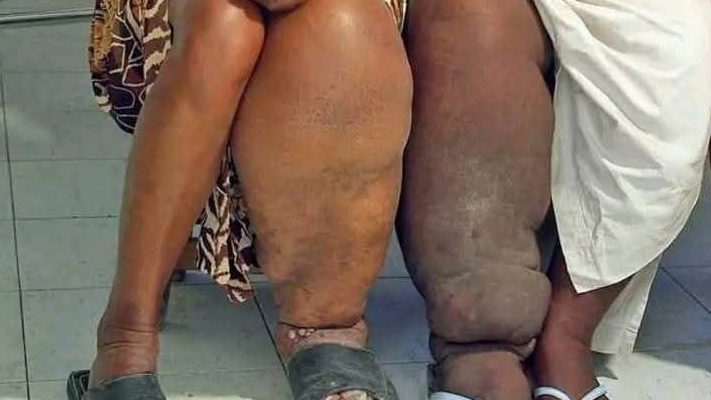 Understanding Elephantiasis and Lymphedema: Causes, Symptoms, and Treatment
Understanding Elephantiasis and Lymphedema: Causes, Symptoms, and Treatment
Swelling of the legs, particularly when it becomes extreme and disfiguring, is not merely a cosmetic issue — it’s a serious medical condition that affects millions of people around the world. The image of enlarged, thickened legs is often associated with a condition known as elephantiasis, a severe form of lymphedema that can cause both physical discomfort and emotional suffering. Understanding its causes, symptoms, and available treatments is essential to promote awareness and compassion for those living with this condition.
What Is Elephantiasis?
Elephantiasis is a disease characterized by massive swelling in certain parts of the body, most commonly the legs, but sometimes also the arms, breasts, or genitals. The name comes from the resemblance of the swollen limbs to the thick, rough skin of an elephant. It occurs when the lymphatic system — a vital part of the body’s immune and circulatory systems — becomes blocked, preventing lymph fluid from draining properly. Over time, this fluid buildup causes the affected tissues to become swollen, thick, and hardened.
The most common form of elephantiasis worldwide is caused by lymphatic filariasis, a parasitic infection transmitted by mosquitoes. However, there are also non-filarial forms caused by genetic disorders, injury, surgery, radiation, or chronic infections that damage the lymphatic vessels.
The Lymphatic System and Why It Matters
To understand elephantiasis, it’s important to know the role of the lymphatic system. This network of vessels and nodes acts as a drainage and filtration system for the body. It collects excess fluid, waste products, and immune cells from tissues and returns them to the bloodstream. When this system is disrupted — due to parasites, surgery, or damage — lymph fluid accumulates in the tissues, leading to lymphedema.
Lymphedema can begin as mild swelling but can progress over time to severe, chronic, and disfiguring enlargement of the affected body part. The skin can become thick, dry, and prone to infections, making daily life extremely difficult.
Causes of Elephantiasis
There are two main categories of elephantiasis: filarial and non-filarial.
-
Filarial Elephantiasis (Lymphatic Filariasis)
This type is caused by microscopic, thread-like parasites known as Wuchereria bancrofti, Brugia malayi, or Brugia timori. These parasites are transmitted through mosquito bites. When an infected mosquito bites a person, the larvae enter the bloodstream, migrate to the lymphatic vessels, and mature into adult worms. Over time, these worms block lymph flow, causing severe swelling and tissue changes.
Filarial elephantiasis is common in tropical and subtropical regions, especially in Africa, South and Southeast Asia, and parts of the Pacific Islands. -
Non-Filarial Elephantiasis (Podoconiosis or Secondary Lymphedema)
This form is not caused by parasites but by repeated exposure to irritant minerals in the soil (common in people who walk barefoot in volcanic areas), chronic infections, tumors, trauma, or surgical removal of lymph nodes (such as after cancer treatment). It can also result from obesity, venous insufficiency, or radiation therapy that damages lymphatic vessels.
In both forms, the root cause is the same: the obstruction of lymph flow leading to fluid retention, swelling, and tissue hardening.
Symptoms and Progression
The condition often develops gradually. In its early stages, the swelling may come and go, especially after periods of rest or elevation. However, as it progresses, the swelling becomes constant and increasingly severe. Common symptoms include:
-
Persistent swelling of part or all of a limb
-
Thickened, dry, and cracked skin
-
Deep skin folds and hardened tissue
-
Pain or discomfort due to the heaviness of the limb
-
Recurrent bacterial infections (cellulitis)
-
Restricted movement and joint stiffness
-
Psychological distress due to disfigurement
In advanced stages, the affected area may emit an unpleasant odor due to chronic infection, and the skin may develop wart-like growths or ulcerations.
Social and Emotional Impact
Beyond the physical suffering, elephantiasis carries a profound emotional and social burden. In many cultures, those affected face stigma, isolation, and discrimination. The visible swelling can cause embarrassment, loss of confidence, and depression. People may lose their ability to work, perform daily tasks, or participate in community life. For women, the condition can be particularly devastating, affecting marriage prospects and social standing.
Global health organizations have recognized lymphatic filariasis as a neglected tropical disease, meaning it predominantly affects the world’s poorest populations — those with limited access to clean water, healthcare, and mosquito control programs. Addressing it is not only a medical challenge but also a humanitarian one.
Diagnosis
Diagnosing elephantiasis involves identifying the underlying cause of the swelling. For filarial cases, blood tests can detect the presence of parasites or antibodies. In non-filarial cases, doctors may use ultrasound, lymphoscintigraphy, or MRI scans to examine the lymphatic vessels and rule out other causes such as deep vein thrombosis or heart disease.
Early diagnosis is critical because treatment is far more effective before the swelling becomes irreversible.
Treatment Options
While there is no cure for advanced elephantiasis, several treatments can help manage symptoms, control infection, and improve quality of life.
-
Medications
-
Antifilarial drugs such as diethylcarbamazine (DEC), ivermectin, and albendazole are used to kill the parasites in filarial elephantiasis.
-
Antibiotics may be prescribed to treat or prevent bacterial infections.
-
Pain relievers and anti-inflammatory medications help reduce discomfort.
-
-
Hygiene and Skin Care
Good hygiene is crucial to prevent infections. Patients are encouraged to wash the affected area daily with soap and water, dry it carefully, and apply antibacterial or moisturizing creams to prevent cracking. -
Compression and Physical Therapy
Using compression bandages or garments can help reduce swelling by encouraging lymph flow. Manual lymph drainage, a special type of massage, may also be recommended under medical supervision. -
Surgery
In some severe cases, surgery may be necessary to remove excess tissue or reconstruct damaged lymphatic vessels. While it cannot completely reverse the condition, it can improve comfort and mobility. -
Emotional and Community Support
Counseling, social support groups, and community education can help reduce stigma and improve emotional well-being.
Prevention
For filarial elephantiasis, prevention focuses on controlling mosquito populations and mass drug administration in endemic regions. The World Health Organization has implemented programs that distribute antifilarial medications to millions of people each year, significantly reducing transmission rates. Using mosquito nets, wearing protective clothing, and improving sanitation also play key roles.
For non-filarial cases, prevention involves wearing shoes to avoid soil irritation, maintaining good hygiene, and managing conditions like obesity or venous disease that strain the lymphatic system.
A Message of Awareness
The image of two individuals with severely swollen legs is more than a medical illustration — it’s a human story of resilience, pain, and the urgent need for global attention. Elephantiasis is a preventable and treatable condition if addressed early, yet many still suffer due to lack of resources and awareness. Through education, compassion, and medical outreach, lives can be transformed.
By shedding light on this condition, we can inspire understanding and empathy rather than stigma. Each swollen leg tells a story — not just of disease, but of endurance, hope, and the ongoing fight for health and dignity

